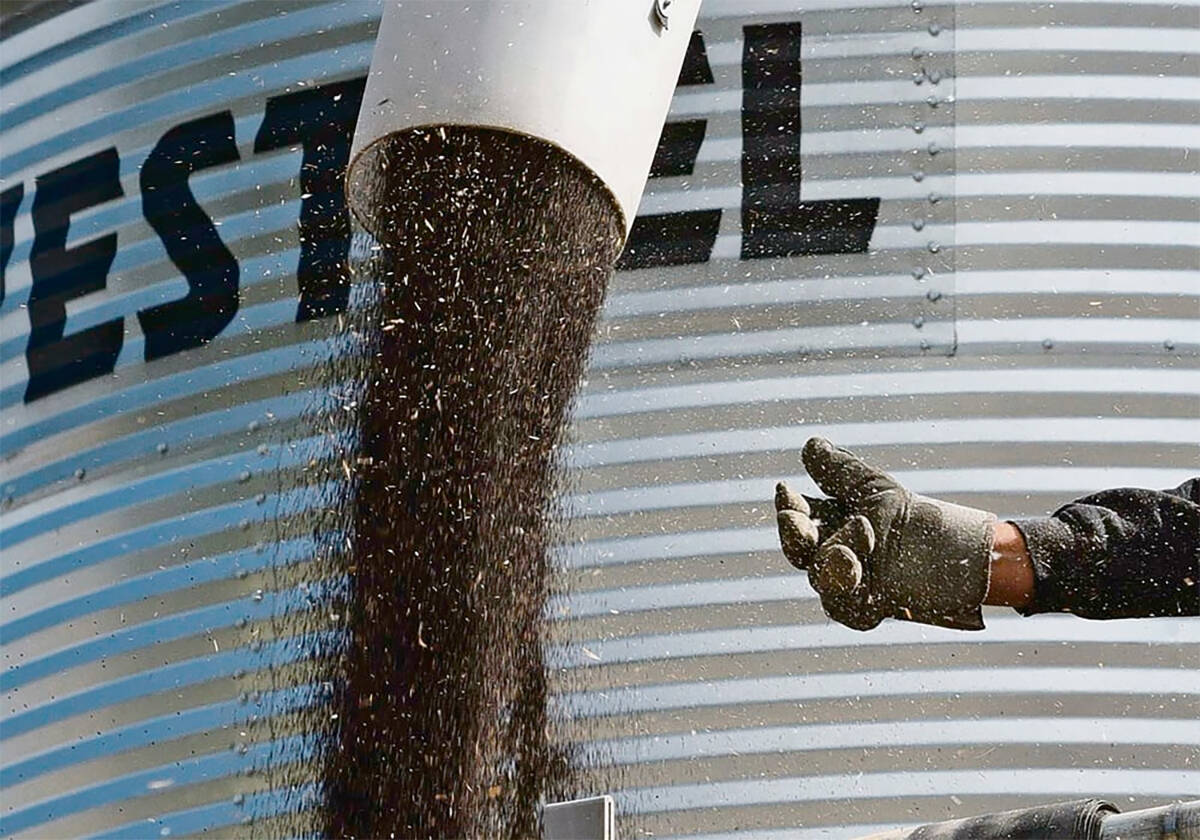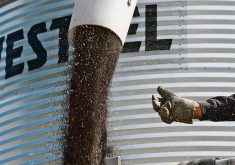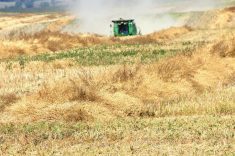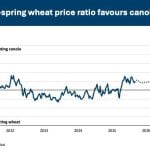Trevor Yurchak has some suggestions about what to do with crops that
are still in the field this fall.
“They all involve feeding it,” the Alberta Agriculture livestock
agrologist said.
It’s estimated that 25 percent of the crop in Alberta, 30 percent in
Saskatchewan and some in Manitoba is still unharvested.
Yurchak said producers without livestock should consider talking to
those who do.
“With feed prices where they are, I imagine they can work something out
Read Also

Farmers urged to be grain-safe this fall
Working around grain bins comes with risk, from farmers falling to drowning in grain: Experts have five tips to help avoid grain-related accidents this harvest.
with neighbours who have animals,” he said.
“It would be better than trying to handle that grain before seeding.”
Agrologists say almost all of the crops still in the field can be fed
if handled correctly.
Producers need to determine the condition of the crop as it was before
the onset of heavy frost and snow.
“Was it nearly ready to harvest, was it close to dry or was it green as
grass?” Yurchak said.
“If it was nearly dry, it means you can’t turn it into silage. If it
was nearly dry you can feed it as baled crop or swath graze. Then it
comes down to safe storage, because there is likely going to be some
moisture in it.”
Vern Racz, head of the Prairie Feed Resource Centre in Saskatoon, said
no matter what producers are going to feed, they need to have it tested
for nitrate levels and feed value.
“You also need to keep in mind that if it is canola, it can contain
large amounts of sulfur, which tie up other minerals in the diet such
as copper and selenium. No matter what you feed, you should use a salt
and mineral supplement.”
Racz said to avoid scours, producers shouldn’t feed more than 40
percent canola as a ration.
Yurchak said swath grazing works well if animals have a water source or
there is snow to eat.
“If it’s fenced, great. Portable electric works for this, too.”
He said if the crop was drying down for harvest, it can be baled a
little at a time and fed immediately without risk of unwanted mould,
yeast or other fungus such as DON containing fusarium.
“If it doesn’t sit, it doesn’t rot. Just bale a day or two’s supply at
a time and feed it until the snow gets too deep,” he said.
“Lots of guys do it anyway and feed this way up to Christmas.”
Brian Doig, a Saskatchewan Agriculture livestock agrologist in North
Battleford, said producers can create their own controlled swath
grazing area without leaving the crop in the field.
“Bale up the crop loosely,” he said.
“Haul back to the farm where the cattle are. Spread it out in two or
three layers. Leave an area between the rows, put up snow fence or
portable electric fence and let the cattle feed on the artificial
swaths …. It will deal with that 30 or 40 percent (moisture hay) and
keep it from heating.”
Doig said the process works equally well if a bale processor is used to
cut and make windrows. Processors will also help “bust up the stocky
stuff.”
“If you’ve got a baler with a preservative kit, or a neighbour has one
you can borrow, you can use that with preservatives in accordance with
manufacturer’s instructions. That will let you bale up a bunch of crop
and store it,” he said.
“You can tube it with bale wrap. But whatever method you use, cover it
and get the air out.”
Yurchak said baled and chopped crop can be effectively treated with
anhydrous ammonia to improve the feed value and storability. Snow will
provide moisture to let the ammonia do its job.
Doig said ammonia will be most effective if the bale’s moisture content
is 20-35 percent and the interior temperature is about 25 C.
“Bale wet and then let them sit for five or six days (to warm). Check
the temperature. It should be in that range. Then treat them with the
ammonia.” he said. The ammonia also kills bacteria and mould.
Green crop can be silaged.
“If it was too dry, it won’t ensile. There won’t be enough sugars left
to start the fermentation.”
Yurchak said the secret to safely stored feed is to cover it with good
plastic that won’t rip in a wind and keeps out the light and air. The
goal is to eliminate oxygen that encourages spoilage.
“If it is ensiled, the material will use up the last of the oxygen and
replace it with carbon dioxide. If the stack is sealed, then there’s no
problem.”
Doig said producers don’t want oxygen even if it isn’t ensiled.
“Without oxygen, moulds and heating won’t get very far,” he said.”The
bales will start to heat, as that bacteria gets going first. It will
burn up any available oxygen and then die. Everything else stops at the
same time.”
Racz said producers can blend their stored crop with better-quality
feed if they are concerned about its safety or overall palatability.
“Stuff like mature canola will have heavy stalks in it. Grind that if
you can. It will allow the animals to make better use of it.”
Racz said feeding regulations must be observed if the crop was treated
with pesticides.
Doig said producers should avoid stacking this fall’s bales, and should
place them away from other hay and farmyards because of fire risk.














